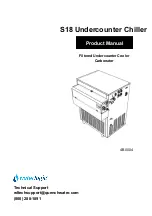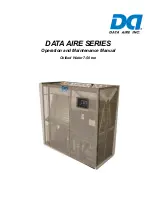
RTWB-SVN01B-E4
34
Maintenance
General
This section describes specific
maintenance procedures that must
be performed as a part of the normal
maintenance program for this unit.
Be certain that electrical power to
the unit is disconnected before
performing these procedures.
W
WA
AR
RN
NIIN
NG
G
Position all electrical disconnects in
the “Open“ position and lock them,
to prevent injury or death due to
electrical shock.
Cleaning the evaporator
The evaporator water system is a
part of a closed loop and should not
accumulate an appreciable amount
of scale or sludge. If it is determined
that the chiller is fouled, attempt to
dislodge any foreign material by
backflushing the system several
times. If this does not work
satisfactorily, chemically clean the
chiller using the procedures outlined
in the following section.
Cleaning the condenser
General
Water that is available for
condensing frequently contains
minerals or other contaminants that
collect on the inside of the
condenser tubes. Scale
accumulation will accelerate with
high condensing temperatures and
the use of water with high mineral
content. Cooling devices collect dust
and foreign material that are also
deposited on the condenser tubes,
forming sludge.
To maintain maximum efficiency, the
condenser must remain as free of
these deposits as possible. Even a
very thin layer on the inside tube
surfaces reduces the heat-transfer
ability of the condenser. Indications
of scale deposits are: decreased
water flow through the condenser,
reduced temperature differential
between the entering and leaving
condenser-water, and abnormally
high condensing temperatures.
There are two accepted methods of
cleaning the condenser tubes, as
discussed in the following
paragraphs.
Mechanical cleaning
The mechanical cleaning method is
used primarily to remove sludge and
other loose material from the
condenser tubes.
Follow the steps below:
Turn off the chiller and condenser
water supplies.
Break piping connections and the
unions.
Remove the condenser heads.
Run a round nylon brush from the
end through the tubes, to loosen
deposits.
Flush the tubes with water. Then
inspect the tubes for scale
accumulation. If there is no scale in
the tubes, reassemble the condenser
and piping.
If there is scale in the tubes, follow
the procedures in the following
paragraph.
Chemical cleaning
Chemical cleaning is the most
satisfactory method of cleaning
scale from the condenser. With this
treatment, scale is dissolved and
flushed away by circulating a
chemical solution through the tubes
and headers.
Internal condenser components are
composed of copper, steel, and cast
iron. With this information, water
treatment firms will be able to
recommend a suitable chemical for
this purpose. If water treatment is
not available, consult a chemical
supply house.
Water treatment
The use of untreated or improperly
treated water in the unit may result
in the formation of scale, algae, or
slime. It may also cause erosion or
corrosion. It is recommended that a
qualified water treatment specialist
provide recommendations for
proper water treatment. The Trane
Company assumes no responsibility
for equipment failure caused by the
use of untreated or improperly
treated water.
Periodic
Maintenance







































